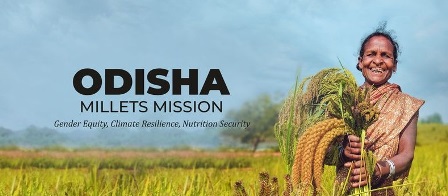Millets: A Boon for Healthy Lifestyle

By Shrikant Panda
There is a unique diversity of food grain productions in India that we don’t find in most parts of the globe. Here, I want to note down numerous types of millets which have to enhance production so that we can solve the food security of the country.
Millets come with a whopping amount of nutrients including proteins, dietary fibre, vitamins, calcium, iron, manganese, magnesium, phosphorus, zinc, potassium & copper. They are also a powerhouse of antioxidants that provide you with impressive health benefits.
Varieties of millets like foxtail, finger, common, pearl and little millet are still available in India but when Green Revolution started in India we emphasized on more food grains like rice and wheat where as successive governments discouraged producing millets which have more nutrient values than rice and wheat.
Our state is no exception as Odisha has been neglecting to further the production of cereal grains. Though we find many tribal regions where water scarcity is rampant, poor tribals have been engaging in producing millets in tribal hinterland but the state government has not provided backing to poor tribal to increase production and create a market for them to sell their products and make them profitable. Now millets have gone beyond the tag of “poor people’s meal” as it’s being used in the upper class now.
Though in late Odisha has drawn its attention to amplify the production of millets under flagship programme of Odisha Millet Mission which was launched in 2017 and the basic objective of this programme is to boost nutrition by reviving millets in farms of tribal communities.
It’s believed that millets are produced with scanty rainfall and its production cost is low in comparison to other crops. Now Odisha has taken a right step to augment millet production in the last few years as a result millet production has spread to 53,230 hectare of land in contrast with 3,333 hectare of land in 2017-2018 which is 14 times higher in five years. As per survey conducted by NCDS in 2018, income has increased from Rs3, 957 to Rs12, 486 per millet farmers which is a good sign for betterment of millet farmers and a lot have to be done by the government to propagate millets in the state.
India proposed FAO to observe an International Year of Millets in 2023 which was approved by FAO in 2018 and subsequently UN General Assembly has declared 2023 as the international year of Millets.
It’s hoped that millet production will have better growth in national and international perspective to safeguard the food security of the planet and several programmes have been launched so far in several states in India in this regard. Recently Odisha has observed Millet Day on 10th of November and millets have been distributed in 15 districts of Odisha through PDS by collecting millets from farmers and sweet dishes of millets have been fed to children in Anganwadi Centre in Keonjhar and Sundergarh.
Numerous food items like vermicelli, biscuits are being prepared by using brand `Millet Shakti” and in this context all districts of the state and other states must take initiative to expand millet cultivation and emphasize the need of selling/buying of these grains in their respective areas. Though rice continued to be the staple food, consumers are now looking for healthy and better food alternatives. This is the reason why millets have now become popular and an excellent alternative for rice. Millet is the healthier version because it’s rich in protein and fibre which is more as compared to rice.
Right now 142 blocks of 19 districts millet farming is going on but the irony of the fact is that only 5 percent of farmers of 9 districts are engaged in such farming which is hindering. There is a need of adopting proactive policy on the part of the state government to proliferate millet farming in every district of the state. So far as other states are concerned states like Uttarakhand and Tamilnadu are way ahead in millet cultivation per hectare and our state must show willingness to top the list in India. Other countries must concentrate on producing millets so that poor countries can nullify food insecurity in their respective areas. Important part of enhancing production of varieties of millets is to sell at an appropriate price so that farmers will get the right value of products to make them profitable in this business. There is a need for brainstorming to prepare different types of millet food items and government must provide incentives to establish small factories to process scores of millet food products in the country.






